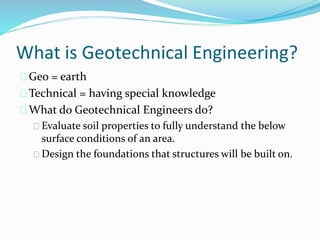The Best Strategy To Use For Geotheta
The Best Strategy To Use For Geotheta
Blog Article
Little Known Facts About Geotheta.
Table of ContentsThe Definitive Guide to GeothetaGeotheta Fundamentals ExplainedGeotheta Things To Know Before You BuyNot known Incorrect Statements About Geotheta The Facts About Geotheta Revealed

They carry out site investigations, accumulate examples, execute laboratory tests, and examine information to review the viability of the ground for building tasks - Geo Tech Engineer. Based on their findings, geotechnical designers give recommendations for structure layout, slope security, maintaining frameworks, and reduction of geotechnical dangers. They team up with various other specialists, such as engineers, architectural engineers, and construction groups, to make certain that geotechnical factors to consider are integrated into the total project style and execution
By examining the habits and residential properties of soil and rock, they can determine prospective geotechnical dangers such as landslides, dirt settlement, or slope instability. Their competence helps prevent failings or mishaps that might threaten lives and residential or commercial property. Here are some in-depth obligations and obligations of a geotechnical engineer: Site Examination: Geotechnical designers conduct site examinations to gather information on subsurface conditions.
They translate the data to recognize the homes and actions of the soil and rock, including their toughness, permeability, compaction features, and groundwater conditions. Geotechnical Analysis and Design: Geotechnical designers evaluate the data collected during site investigations to evaluate the stability and viability of the website for building and construction jobs. They perform geotechnical calculations and modeling to examine variables such as bearing ability, negotiation, slope security, side earth stress, and groundwater circulation.
The 8-Minute Rule for Geotheta
Foundation Style: Geotechnical designers play an essential duty in developing structures that can securely sustain the designated framework. They assess the dirt conditions and load needs to identify the appropriate structure type, such as superficial foundations (e.g., footings), deep structures (e.g (https://www.tripadvisor.in/Profile/geotheta1)., stacks), or specialized methods like soil enhancement. They take into consideration variables such as negotiation restrictions, bearing capacity, and soil-structure communication to develop optimum structure styles
They evaluate building and construction plans, monitor site activities, and perform area assessments to confirm that the style referrals are followed. If unanticipated geotechnical problems occur, they examine the circumstance and offer recommendations for remediation or modifications to the design. Danger Assessment and Reduction: Geotechnical designers evaluate geotechnical hazards and risks related to the job site, such as landslides, liquefaction, or soil erosion.

Cooperation and Interaction: Geotechnical engineers function closely with various other experts associated with a task, such as designers, structural designers, and construction teams. Effective interaction and collaboration are vital to incorporate geotechnical factors to consider right into the total project style and building and construction process. Geotechnical designers offer technological know-how, answer inquiries, and guarantee that geotechnical demands are met.
Geotheta - The Facts
Here are some sorts of geotechnical designers: Foundation Engineer: Structure engineers focus on developing and examining structures for frameworks. They evaluate the dirt problems, tons demands, and site attributes to identify the most proper structure type and design, such as superficial foundations, deep foundations, or specialized methods like pile foundations.
They review the elements influencing slope stability, such as dirt homes, groundwater conditions, and incline geometry, and establish approaches to stop slope failures and minimize dangers. Earthquake Engineer: Quake designers focus on evaluating and designing structures to endure seismic forces. They assess the seismic hazard of a website, assess dirt liquefaction possibility, and establish seismic design standards to make sure the safety and security and resilience of structures during earthquakes.
They carry out field screening, accumulate samples, and evaluate the collected information to define the soil homes, geologic developments, and groundwater problems at a site. Geotechnical Instrumentation Engineer: Geotechnical instrumentation engineers focus on tracking and gauging the habits of dirt, rock, and frameworks. They install and preserve instrumentation systems that keep track of variables such as dirt negotiation, groundwater levels, slope motions, and architectural variations to assess efficiency and supply early warnings of prospective problems.
6 Easy Facts About Geotheta Shown
They perform tests such as triaxial examinations, consolidation examinations, direct shear examinations, and permeability examinations to gather information for geotechnical analysis and layout. Geosynthetics Engineer: Geosynthetics designers concentrate on the layout and application of geosynthetic products, such as geotextiles, geogrids, and geomembranes. They use these products to improve dirt stability, strengthen inclines, provide water drainage solutions, and control erosion.
They have a tendency to be investigatory individuals, which means they're intellectual, introspective, and curious. They are interested, systematic, sensible, analytical, and rational. Some of them are additionally social, indicating they're kind, generous, participating, client, caring, helpful, understanding, skillful, and friendly. Does this sound like you? Take our cost-free job examination to find out if geotechnical engineer is among your top career matches.
In the office environment, geotechnical engineers make use of specialized software tools to perform estimations, produce layouts, and analyze information. They prepare records, review project requirements, communicate with customers and employee, and coordinate task activities. The workplace setup supplies a helpful environment for research, analysis, and partnership with other professionals associated with the task.
The Best Strategy To Use For Geotheta
They often go to job sites to perform site examinations, assess geotechnical conditions, and collect data for analysis. These sees involve taking a trip to different areas, often in remote or tough terrains. Geotechnical designers might do soil sampling, conduct tests, and display building tasks to guarantee that the geotechnical aspects of the task are being executed correctly.
Geotechnical designers additionally function in specialized geotechnical laboratories. In these centers, they carry out experiments, perform tests on dirt and rock examples, and evaluate the engineering properties of the materials. Geotechnical laboratory designers function thoroughly in these settings, dealing with testing tools, running tools, and recording information. They collaborate with other lab staff to ensure precise and trustworthy testing outcomes.
Report this page